GATE 2023 Humanities and Social Sciences – Sociology (XH-C6) Question Paper PDF is available here for download. IIT Kanpur conducted GATE 2023 Humanities and Social Sciences – Sociology (XH-C6) exam on February 5, 2023 in the Forenoon Session from 09:30 AM to 12:30 PM. Students have to answer 65 questions in GATE 2023 Humanities & Social Sciences Sociology Question Paper carrying a total weightage of 100 marks. 10 questions are from the General Aptitude section and 55 questions are from Core Discipline.
GATE 2023 Humanities and Social Sciences – Sociology (XH-C6) Question Paper with Solutions PDF
| GATE 2023 Humanities and Social Sciences – Sociology (XH-C6) Question Paper with Solutions | Check Solutions |

Rafi told Mary, “I am thinking of watching a film this weekend.”
The following reports the above statement in indirect speech:
Rafi told Mary that he ______ of watching a film that weekend.
Permit : ______ :: Enforce : Relax \quad (By word meaning)
Given a fair six-faced dice where the faces are labelled ‘1’, ‘2’, ‘3’, ‘4’, ‘5’, and ‘6’, what is the probability of getting a ‘1’ on the first roll of the dice and a ‘4’ on the second roll?
A recent survey shows that 65% of tobacco users were advised to stop consuming tobacco. The survey also shows that 3 out of 10 tobacco users attempted to stop using tobacco.
Based only on the information in the above passage, which one of the following options can be logically inferred with certainty?
How many triangles are present in the given figure?

Students of all the departments of a college who have successfully completed the registration process are eligible to vote in the upcoming college elections. By the due date, \emph{none} of the students from the Department of Human Sciences had completed the registration process. Which set(s) of statements can be inferred with certainty?
(i) All those students who would not be eligible to vote would certainly belong to the Department of Human Sciences.
(ii) None of the students from departments other than Human Sciences failed to complete the registration process within the due time.
(iii) All the eligible voters would certainly be students who are not from the Department of Human Sciences.
Which one of the following options represents the given graph?
Which one of the options does NOT describe the passage below or follow from it?
Passage:
We tend to think of cancer as a ‘modern’ illness because its metaphors are so modern. It is a disease of overproduction, of sudden growth, a growth that is unstoppable, tipped into the abyss of no control. Modern cell biology encourages us to imagine the cell as a molecular machine. Cancer is that machine unable to quench its initial command (to grow) and thus transform into an indestructible, self-propelled automaton.
The digit in the unit’s place of the product \(3^{999}\times 7^{1000}\) is ______.
A square with sides of length \(6\,cm\) is given. The boundary of the shaded region is defined by two semi-circles whose diameters are the sides of the square, as shown. The area of the shaded region is ______ \(cm^2\).

Which word below best describes the idea of being both Spineless and Cowardly?
Choose the right preposition to fill up the blank:
The whole family got together ___ Diwali
Select the correct option to fill in all the blanks to complete the passage:
The (i)______ factor amid this turbulence has been the (ii)______ of high-octane, action-oriented films such as RRR, K.G.F: Chapter 2 and Pushpa from film industries in the south of the country. Traditionally, films made in the south have done well in their own (iii)______. But increasingly, their dubbed versions have performed well in the Hindi heartland, with collections (iv)______ those of their Bollywood counterparts.
The following passage consists of 6 sentences. The first and sixth sentences of the passage are at their correct positions, while the middle four sentences (represented by 2, 3, 4, and 5) are jumbled up.
Choose the correct sequence of the sentences so that they form a coherent paragraph:
1. Most obviously, mobility is taken to be a geographical as well as a social phenomenon.
2. Much of the social mobility literature regarded society as a uniform surface and failed to register the geographical intersections of region, city and place, with the social categories of class, gender and ethnicity.
3. The existing sociology of migration is incidentally far too limited in its concerns to be very useful here.
4. Further, I am concerned with the flows of people within, but especially beyond, the territory of each society, and how these flows may relate to many different desires, for work, housing, leisure, religion, family relationships, criminal gain, asylum seeking and so on.
5. Moreover, not only people are mobile but so too are many ‘objects’.
6. I show that sociology’s recent development of a ‘sociology of objects’ needs to be taken further and that the diverse flows of objects across societal borders and their intersections with the multiple flows of people are hugely significant.
The population of a country increased by 5% from 2020 to 2021. Then, the population decreased by 5% from 2021 to 2022. By what percentage did the population change from 2020 to 2022?
The words {Thin: Slim: Slender} are related in some way. Identify the correct option(s) that reflect(s) the same relationship:
A pandemic like situation hit the country last year, resulting in loss of human life and economic depression. To improve the condition of its citizens, the government made a series of emergency medical interventions and increased spending to revive the economy. In both these efforts, district administration authorities were actively involved.
Which of the following action(s) are plausible?
Six students, Arif (Ar), Balwinder (Bw), Chintu (Ct), David (Dv), Emon (Em) and Fulmoni (Fu) appeared in GATE–XH (2022).
Bw scores less than Ct in XH–B1, but more than Ar in XH–C1.
Dv scores more than Bw in XH–C1, and more than Ct in XH–B1.
Em scores less than Dv, but more than Fu in XH–B1.
Fu scores more than Dv in XH–C1.
Ar scores less than Em, but more than Fu in XH–B1.
Who scores highest in XH–B1?
Select the correct relation between \(E\) and \(F\). \quad \(E=\dfrac{x}{1+x}\) \; and \; \(F=\dfrac{-x}{\,1-x\,}\), \; with \(x>1\).
A code language is formulated thus:
Vowels in the original word are replaced by the next vowel from the list of vowels, A-E-I-O-U (For example, E is replaced by I and U is replaced by A). Consonants in the original word are replaced by the previous consonant (For example, T is replaced by S and V is replaced by T).
Then how does the word, GOODMORNING appear in the coded language?
The stranger is by nature no "owner of soil" -- soil not only in the physical, but also in the figurative sense of a life-substance, which is fixed, if not in a point in space, at least in an ideal point of the social environment. Although in more intimate relations, he may develop all kinds of charm and significance, as long as he is considered a stranger in the eyes of the other, he is not an "owner of soil." Restriction to intermediary trade, and often (as though sublimated from it) to pure finance, gives him the specific character of mobility. If mobility takes place within a closed group, it embodies that synthesis of nearness and distance which constitutes the formal position of the stranger. For, the fundamentally mobile person comes in contact, at one time or another, with every individual, but is not organically connected, through established ties of kinship, locality, and occupation, with any single one.
What assumptions can be made about the stranger from the passage above?
L is the only son of A and S. S has one sibling, B, who is married to L’s aunt, K. B is the only son of D. How are L and D related? Select the possible option(s):
The following segments of a sentence are given in jumbled order. The first and last segments (1 and 5) are in their correct positions, while the middle three segments (represented by 2, 3, and 4) are jumbled up. Choose the correct order of the segments so that they form a coherent sentence:
1. Consumed multitudes are jostling and shoving inside me
2. and guided only by the memory of a large white bedsheet with a roughly circular hole some seven inches in diameter cut into the center,
3. clutching at the dream of that holey, mutilated square of linen, which is my
talisman, my open-sesame,
4. I must commence the business of remaking my life from the point at which
it really began,
5. some thirty-two years before anything as obvious, as present, as my clockridden, crime-stained birth.
“I told you the truth,” I say yet again, “Memory’s truth, because memory has its own special kind. It selects, eliminates, alters, exaggerates, minimizes, glorifies, and vilifies also; but in the end it creates its own reality, its heterogeneous but usually coherent versions of events; and no sane human being ever trusts someone else’s version more than his own.”
What are the different ways in which ‘truth’ can be understood from the passage?
A firm needs both skilled labour and unskilled labour. Skilled wage = Rs. 40{,}000 per month; unskilled wage = Rs. 15{,}000 per month. The total wage bill for 100 labourers is Rs. 23{,}75{,}000 in a month. How many skilled labour are employed? \emph{(in Integer)}
Select the odd word and write the option number as answer:
__________ has given the concept of `thick description'.
Objectivity in social science research as a matter of transpersonal replicability entails ____________.
Which of the following is NOT a characteristic of hypothesis?
________________ theory most appropriately describes a hierarchy of wealthy ‘core’ nations, poor ‘periphery’ nations, and a middle group of ‘semi-periphery’ nations.
In Hindu society, marriage of a widow to the husband’s brother is referred to as ____________.
Because of Covid-19 lockdown, many working-class people lost jobs and prices rose, worsening their economic condition. Which concept of Karl Marx best describes this ‘increasing impoverishment’ of the poor in contemporary times?
__________ coined the term, ‘ethnocentrism’.
Supremacy of science over non-sciences is attributed to ___________.
Communism, universalism, disinterestedness and _______________ constitute Mertonian ethos of science.
_______________ theory postulates that developing economies will catch up with developed economies if they follow the social and economic models of Western capitalism.
__________ approach was NOT propounded by B. S. Cohn as one of the approaches to study Indian civilization.
If standard deviation is 0.3, then its corresponding variance would be _______________.
Under _____________ land tenurial system during the British rule in India, the individual cultivator/peasant had some ownership right over land holding.
_______________ introduced the concept of ‘reconstructive science’.
__________ theory lies between minor working hypotheses and master conceptual schemes.
__________ is NOT a characteristic feature of M.N. Srinivas’s concept of ‘dominant caste’.
Max Weber’s instrumental rationality refers to ________.
The stable pattern of ‘modern men’ formulated by Alex Inkeles does not include ________.
_______________ refers to the careful consideration of the ways in which researchers’ past experiences, points of view, and roles impact these same researchers’ interactions with, and interpretations of, the research scene.
_______________ introduced the concept of _______________ to describe situations where people accept, consent to, and internalize values and norms that are not in their best interests.
__________ is the process by which researchers begin by identifying several participants who fit the study’s criteria and then ask these people to suggest a colleague, a friend, or a family member who also fits the study’s criteria.
Match the following sociologists in Column P with their views on religion in Column Q.
| Column P | Column Q |
|---|---|
| A) Karl Marx | I) Opiate of the peopleOpiate of the people |
| B) Max Weber | II) Sources of social solidaritySources of social solidarity |
| C) Clifford Geertz | III) A source of capitalist outlookA source of capitalist outlook |
| D) Emile Durkheim | IV) A cultural systemA cultural system |
| V) A source of modernityA source of modernity |
There are four forms of triangulation, namely data triangulation, ___________, theory triangulation and ___________.
__________ is the process by which groups seek to preserve some advantage by monopolizing resources and restricting access to the group.
Correlation coefficient lies between _______ and ________, and probability lies between _______ and ________.
Match the following concepts as given in Column P with the Sociologists as given in Column Q:
| Column P | Column Q |
|---|---|
| A) Systematic falsification | I) Thomas Kuhn |
| B) Systematic verification | II) Emile Durkheim |
| C) Consensus | III) Karl Popper |
| D) Social fact | IV) Positivism |
Match the following approaches and village study as given in Column P with Sociologists as given in Column Q:
| Column P | Column Q |
|---|---|
| A. Rampura village | I. Sharmila Rege |
| B. Indology | II. M.N. Srinivas |
| C. Marxist approach | III. A.R. Desai |
| D. Feminist perspective | IV. Irawati Karve |
According to the World Commission on Environment and Development, ‘sustainable development’ refers to _________.
According to David Pocock, the Indian Jajmani system reflects _______________.
Which of the following is/are NOT characteristic(s) of the \emph{class} system?
Which of the following concept(s) is/are NOT propounded by Emile Durkheim?
The example(s) of relations of production is/are _______________.
While __________ emerges around a charismatic figure, idea or vision, __________ emerges as a breakaway group from a preexisting body of belief, rituals, or believers.
Which of the following statement(s) is/are true for the Forest Rights Act (2006) of India?
The Ethnographic Survey of India as part of the Census 1901 was conducted to _____________.
__________ and __________ propounded conflict theory.
Which of the following is/are NOT aspect(s) of secularization process?
Which of the following pair(s) is/are correct?
M1: Michel Foucault _______________ M2: Pierre Bourdieu _______________ M3: John Urry
X1: Archaeology of Knowledge _______________ X2: Sociological Imagination _______________ X3: Practice Theory
Which of the following statement(s) is/are INCORRECT?



















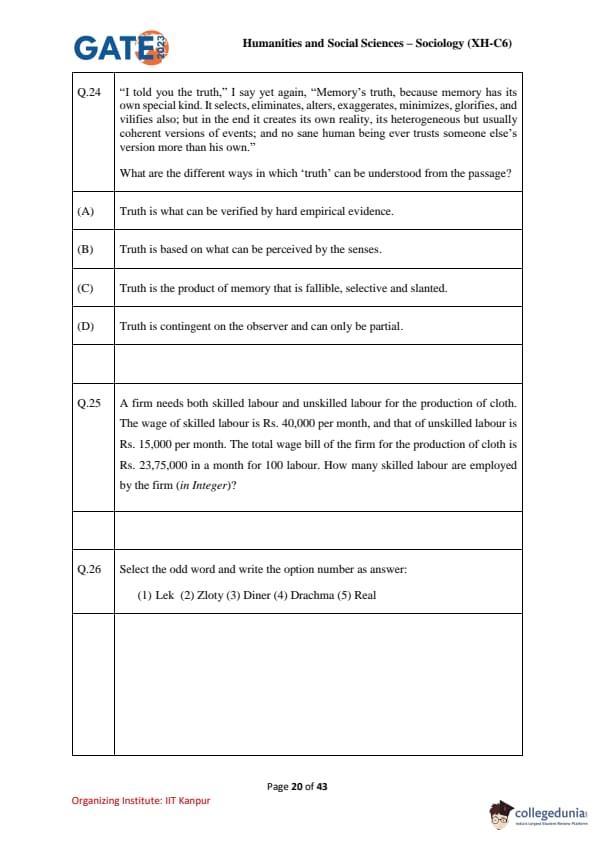



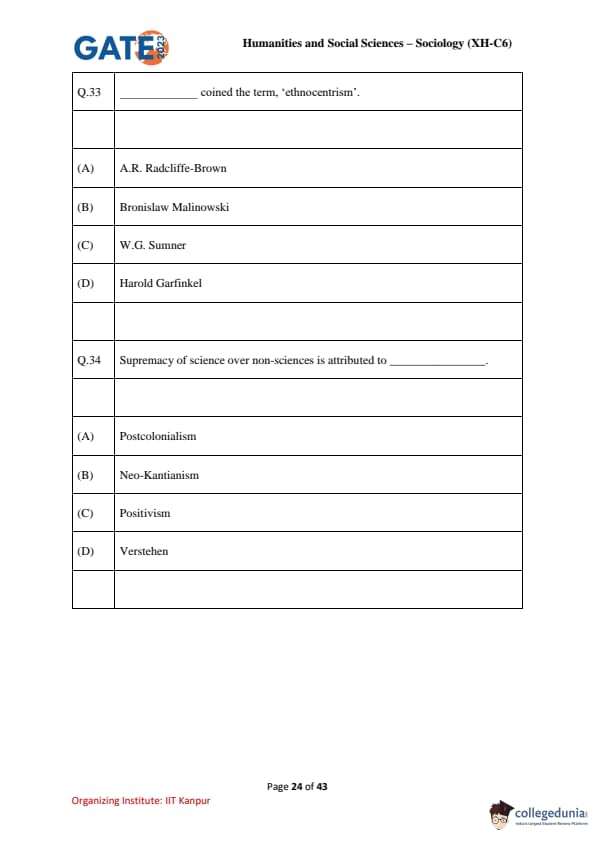


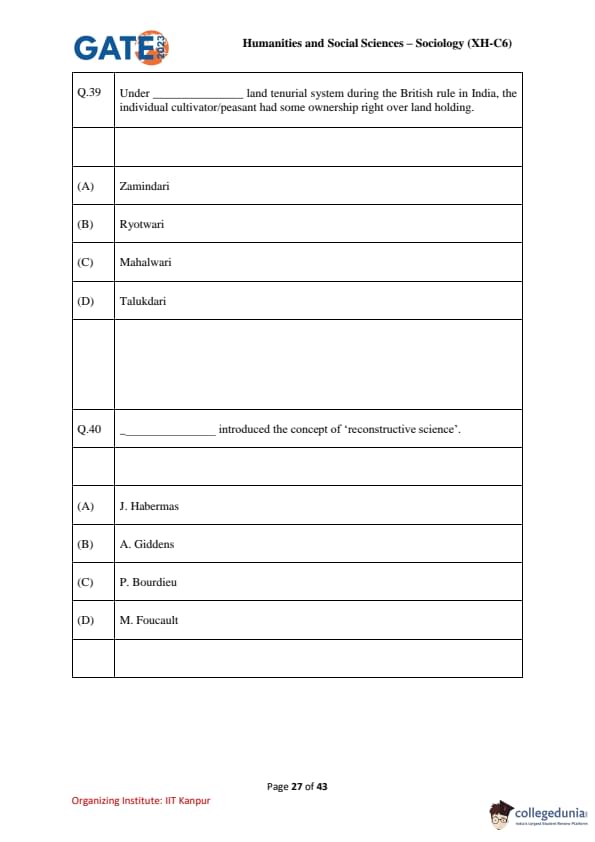
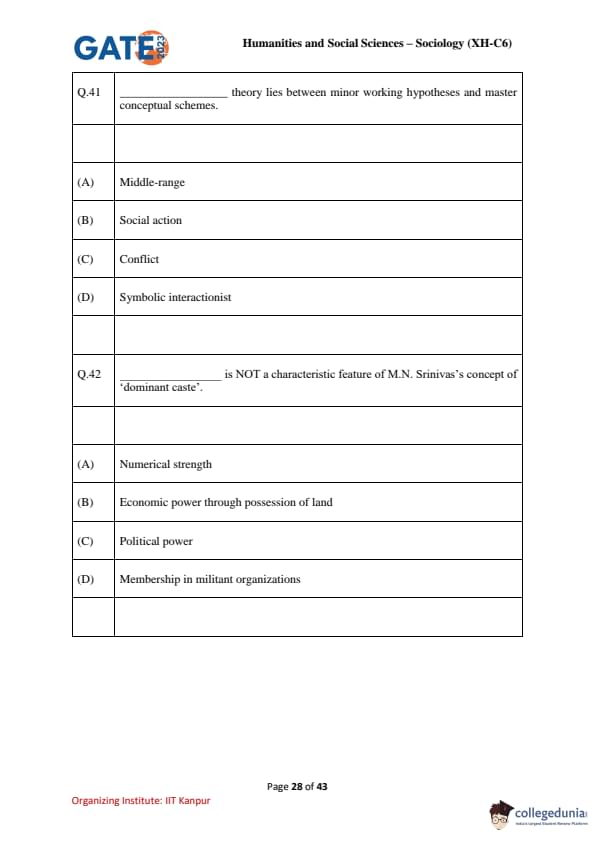
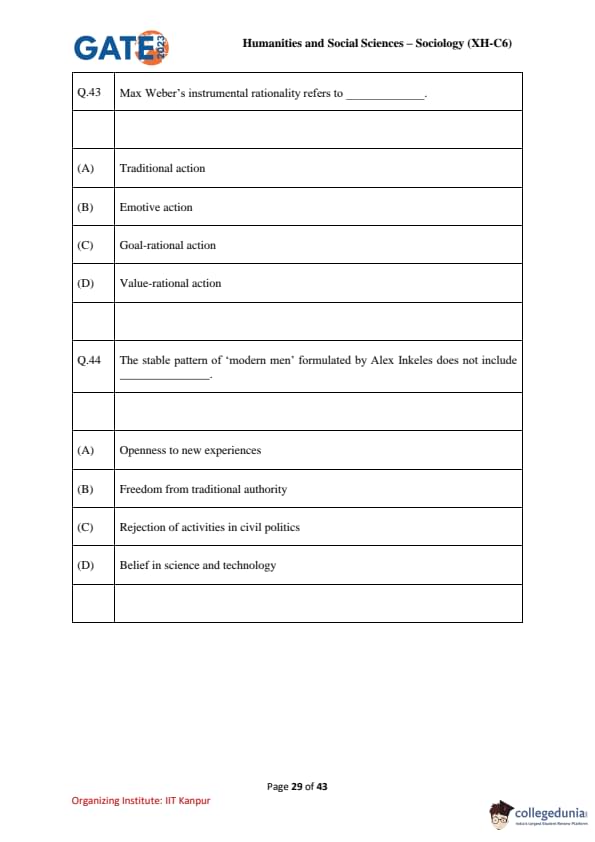


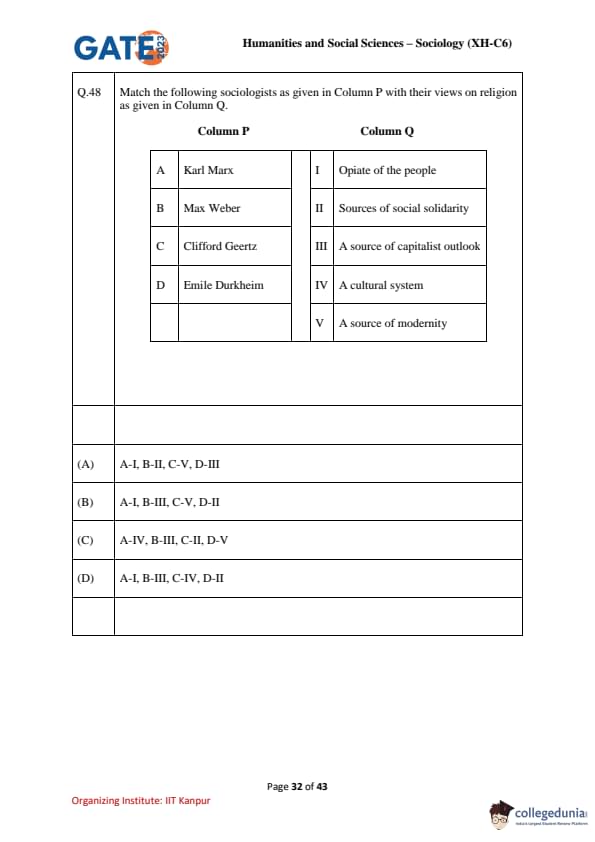
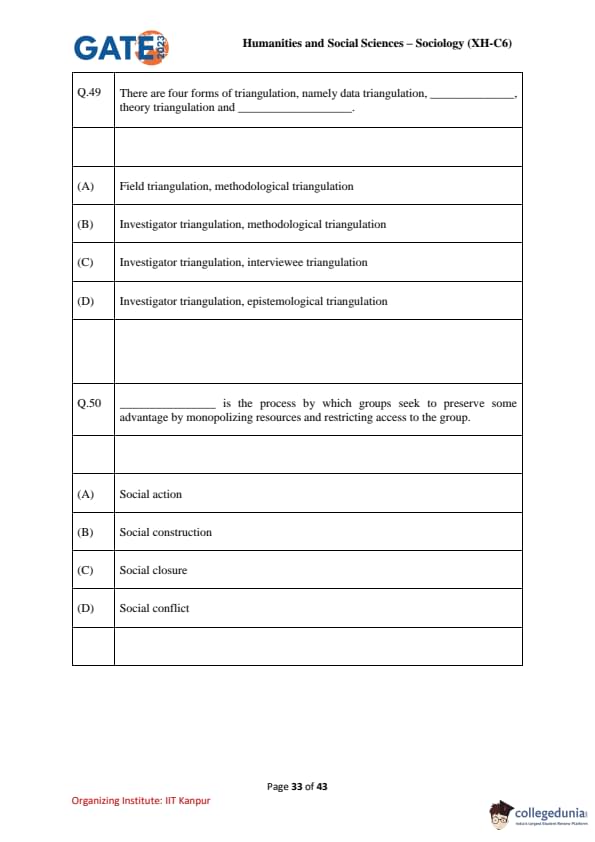
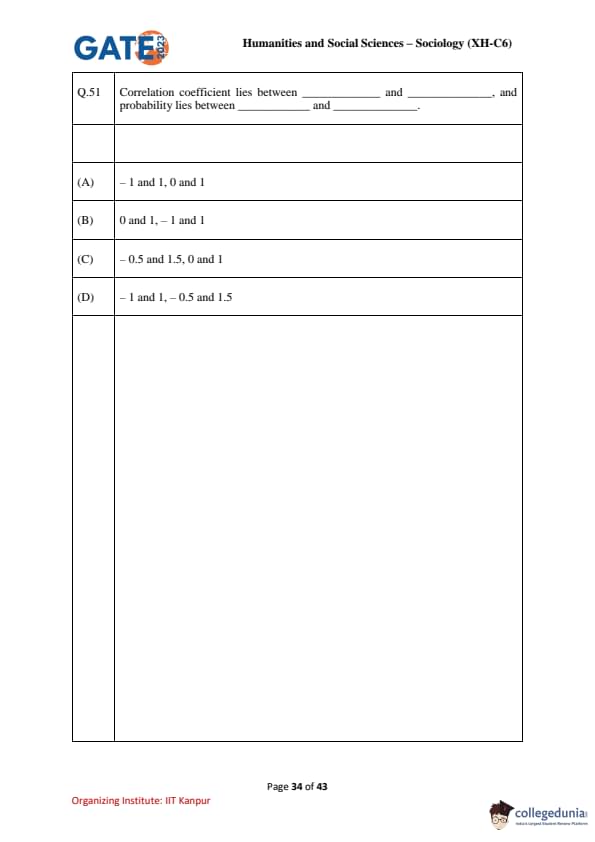

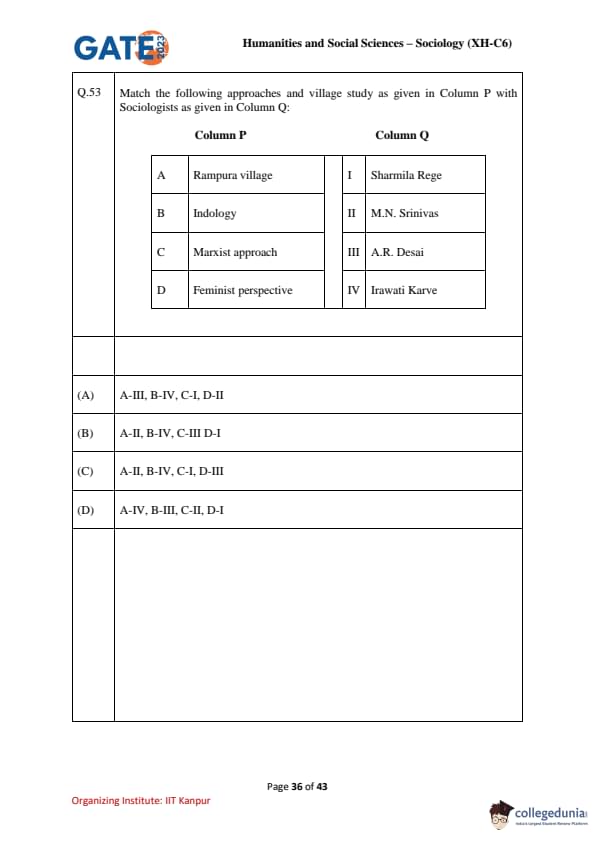

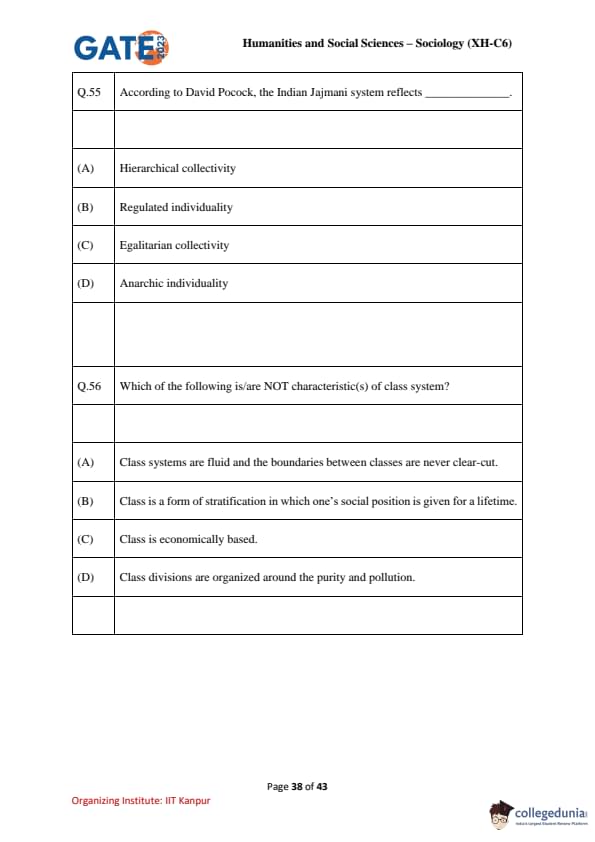







Also Check:
| Previous Year GATE Humanities & Social Sciences Question Papers | GATE 2023 Humanities & Social Sciences Paper Analysis |



Comments